Seasonal Changes of Extremes in Isolated and Mesoscale Precipitation for the Southeastern United States
Abstract
1. Introduction
2. Data and Approach
3. Results
4. Summary and Conclusions
Funding
Acknowledgments
Conflicts of Interest
References
- Karl, T.; Knight, R.W. Secular trends of precipitation amount, frequency, and intensity in the United States. Bull. Am. Meteorol. Soc. 1998, 79, 231–242. [Google Scholar] [CrossRef]
- Emori, S.; Brown, S.J. Dynamic and thermodynamic changes in mean and extreme precipitation under changed climate. Geophys. Res. Lett. 2005, 32. [Google Scholar] [CrossRef]
- Wang, Y.; Zhou, L. Observed trends in extreme precipitation events in China during 1961–2001 and the associated changes in large-scale circulation. Geophys. Res. Lett. 2005, 32. [Google Scholar] [CrossRef]
- Trenberth, K. Changes in precipitation with climate change. Clim. Res. 2011, 47, 123–138. [Google Scholar] [CrossRef]
- Allen, M.; Ingram, W. Constraints on future changes in climate and the hydrologic cycle. Nature 2002, 419, 224–232. [Google Scholar] [CrossRef] [PubMed]
- Allan, R.; Soden, B. Atmospheric warming and the amplification of precipitation extremes. Science 2008, 321, 1481–1484. [Google Scholar] [CrossRef] [PubMed]
- Liu, S.C.; Fu, C.; Shiu, C.J.; Chen, J.P.; Wu, F. Temperature dependence of global precipitation extremes. Geophys. Res. Lett. 2009, 36, L17702. [Google Scholar] [CrossRef]
- Trenberth, K. Conceptual framework for changes of extremes of the hydrological cycle with climate change. Clim. Chang. 1999, 42, 327–339. [Google Scholar] [CrossRef]
- Kunkel, K.; Easterling, D.; Kristovich, D.; Gleason, B.; Stoecker, L.; Smith, R. Recent increases in U.S. heavy precipitation associated with tropical cyclones. Geophys. Res. Lett. 2010, 37, L24706. [Google Scholar] [CrossRef]
- Mock, C. Climatic controls and spatial variations of precipitation in the western United States. J. Clim. 1996, 9, 1111–1125. [Google Scholar] [CrossRef]
- Curtis, S.; Salahuddin, A.; Adler, R.; Huffman, G.; Gu, G.; Hong, Y. Precipitation extremes estimated by GPCP and TRMM: ENSO relationships. J. Hydrometeorol. 2007, 8, 678–689. [Google Scholar] [CrossRef]
- Gadgil, S.; Vinayachandran, P.; Francis, P.; Gadgil, S. Extremes of the Indian summer monsoon rainfall, ENSO and equatorial Indian Ocean oscillation. Geophys. Res. Lett. 2004, 31. [Google Scholar] [CrossRef]
- Boers, N.; Bookhagen, B.; Marwan, N.; Kurths, J.; Marengo, J. Complex networks identify spatial patterns of extreme rainfall events of the South American Monsoon System. Geophys. Res. Lett. 2013, 40, 4386–4392. [Google Scholar] [CrossRef]
- Xu, W.; Zipser, E.; Chen, Y.L.; Liu, C.; Liou, Y.C.; Lee, W.C.; Jou, B.J. An orography-associated extreme rainfall event during TiMREX: Initiation, storm evolution, and maintenance. Mon. Weather Rev. 2012, 140, 2555–2574. [Google Scholar] [CrossRef]
- Mapes, B.; Warner, T.; Xu, M.; Negri, A. Diurnal patterns of rainfall in northwestern South America. Part I: Observations and context. Mon. Weather Rev. 2003, 131, 799–812. [Google Scholar] [CrossRef]
- Ralph, F.M.; Dettinger, M. Historical and national perspectives on extreme west coast precipitation associated with atmospheric rivers during December 2010. Bull. Am. Meteorol. Soc. 2012, 93, 783–790. [Google Scholar] [CrossRef]
- Hohenegger, C.; Brockhaus, P.; Bretherton, C.; Schär, C. The soil moisture-precipitation feedback in simulations with explicit and parameterized convection. J. Clim. 2009, 22, 5003–5020. [Google Scholar] [CrossRef]
- Laing, A.; Fritsch, J.; Negri, A. Contribution of mesoscale convective complexes to rainfall in Sahelian Africa: Estimates from geostationary infrared and passive microwave data. J. Appl. Meteorol. Climatol. 1999, 38, 957–964. [Google Scholar] [CrossRef]
- Nesbitt, S.W.; Zipser, E.J. The diurnal cycle of rainfall and convective intensity according to three years of TRMM measurements. J. Clim. 2003, 16, 1456–1475. [Google Scholar] [CrossRef]
- Schiermeier, Q. The real holes in climate science. Nature 2010, 463, 284–287. [Google Scholar] [CrossRef] [PubMed]
- Kao, S.-C.; Ganguly, A. Intensity, duration and frequency of precipitation extremes under 21st century warming scenarios. J. Geophys. Res. 2011, 116, D16119. [Google Scholar] [CrossRef]
- Hourdin, F.; Grandpeix, J.-Y.; Rio, C.; Bony, S.; Jam, A.; Cheruy, F.; Rochetin, N.; Fairhead, L.; Idelkadi, A.; Musat, I.; et al. LMDZ5B: The atmospheric component of the IPSL climate model with revisited parameterizations for clouds and convection. Clim. Dyn. 2013, 40, 2193–2222. [Google Scholar] [CrossRef]
- O’Gorman, P.; Schneider, T. The physical basis for increases in precipitation extremes in simulations of 21st century climate change. Proc. Natl. Acad. Sci. USA 2009, 106, 14773–14777. [Google Scholar] [CrossRef] [PubMed]
- Houze, R. Observed structure of mesoscale convective systems and implications for large-scale heating. Q. J. R. Meteorol. Soc. 1989, 115, 425–461. [Google Scholar] [CrossRef]
- Curtis, S. Developing a climatology of the South’s ‘other’ storm season: ENSO impacts on winter extratropical cyclogenesis. Southeast. Geogr. 2006, 46, 231–244. [Google Scholar] [CrossRef]
- Nieto Ferreira, R.; Hall, L.; Rickenbach, T. A climatology of the structure, evolution and propagation of midlatitude cyclones in the southeast United States. J. Clim. 2013, 26, 8406–8421. [Google Scholar] [CrossRef]
- Larson, J.; Zhou, Y.; Higgins, R.W. Characteristics of landfalling tropical cyclones in the United States and Mexico: Climatology and interannual variability. J. Clim. 2005, 18, 1247–1262. [Google Scholar] [CrossRef]
- Shepherd, J.M.; Grundstein, A.; Mote, T. Quantifying the contribution of tropical cyclones to extreme rainfall along the coastal southeastern United States. Geophys. Res. Lett. 2007, 34, L23810. [Google Scholar] [CrossRef]
- Koch, S.; Ray, C. Mesoanalysis of summertime convergence zones in central and eastern North Carolina. Weather Forecast. 1997, 12, 56–77. [Google Scholar] [CrossRef]
- Parker, M.D.; Ahijevych, D.A. Convective episodes in the east-central United States. Mon. Weather Rev. 2007, 135, 3707–3727. [Google Scholar] [CrossRef]
- Winkler, J.A.; Skeeter, B.R.; Yamamoto, P.D. Seasonal variations in the diurnal characteristics of heavy hourly precipitation across the United States. Mon. Weather Rev. 1988, 116, 1641–1658. [Google Scholar] [CrossRef]
- Leary, C.; Houze, R. The structure and evolution of convection in a tropical cloud cluster. J. Atmos. Sci. 1979, 36, 437–457. [Google Scholar] [CrossRef]
- Wallace, J. Diurnal variations in precipitation and thunderstorm frequency over the conterminous United States. Mon. Weather Rev. 1975, 103, 406–419. [Google Scholar] [CrossRef]
- Carbone, R.; Tuttle, J. Rainfall occurrence in the U.S. warm season: The diurnal cycle. J. Clim. 2008, 21, 4132–4146. [Google Scholar] [CrossRef]
- Rickenbach, T.M.; Nieto-Ferreira, R.; Zarzar, C.; Nelson, B. A seasonal and diurnal climatology of precipitation organization in the southeastern United States. Q. J. R. Meteorol. Soc. 2015, 141, 1938–1956. [Google Scholar] [CrossRef]
- Rickenbach, T.M.; Rutledge, S.A. Convection in TOGA COARE: Horizontal scale, morphology and rainfall production. J. Atmos. Sci. 1998, 55, 2715–2729. [Google Scholar] [CrossRef]
- Nesbitt, S.W.; Zipser, E.J.; Cecil, D.J. A census of precipitation features in the tropics using TRMM: Radar, ice scattering, and lightning observations. J. Clim. 2000, 13, 4087–4106. [Google Scholar] [CrossRef]
- Nesbitt, S.W.; Cifelli, R.; Rutledge, S.A. Storm morphology and rainfall characteristics of TRMM precipitation features. Mon. Weather Rev. 2006, 134, 2702–2721. [Google Scholar] [CrossRef]
- Rickenbach, T.M.; Nieto-Ferreira, R.; Barnhill, R.; Nesbitt, S. Regional contrast of mesoscale convective system structure prior to and during monsoon onset across South America. J. Clim. 2011, 24, 3753–3763. [Google Scholar] [CrossRef]
- Rickenbach, T.M.; Nieto-Ferreira, R.; Barnhill, R.; Nesbitt, S. Seasonal and regional differences in the rainfall and intensity of isolated convection over South America. Int. J. Climatol. 2013, 33, 2002–2007. [Google Scholar] [CrossRef]
- Liu, C.; Zipser, E. Regional variation of morphology of organized convection in the tropics and subtropics. J. Geophys. Res. Atmos. 2013, 118, 453–466. [Google Scholar] [CrossRef]
- Keenan, T.D.; Carbone, R.E. A preliminary morphology of precipitation systems in tropical northern Australia. Q. J. R. Meteorol. Soc. 1992, 118, 283–326. [Google Scholar] [CrossRef]
- Miller, P.; Mote, T. A climatology of weakly forced and pulse thunderstorms in the Southeast United States. J. Appl. Meteorol. Climatol. 2017, 56, 3017–3033. [Google Scholar] [CrossRef]
- Zhang, J.; Howard, K.; Vasiloff, S.; Langston, C.; Kaney, B.; Arthur, A.; Van Cooten, S.; Kelleher, K.; Kitzmiller, D.F.; Ding, F. National Mosaic and QPE (NMQ) System: description, results, and future plans. Bull. Am. Meteorol. Soc. 2011, 92, 1321–1338. [Google Scholar] [CrossRef]
- Steiner, M.; Houze, R.; Yuter, S. Climatological characterization of three-dimensional storm structure from operational radar and rain gauge data. J. Appl. Meteorol. 1995, 34, 1978–2007. [Google Scholar] [CrossRef]
- Marks, D.; Wolff, D.; Silberstein, D.; Tokay, A.; Pippitt, J.; Wang, J. Availability of high-quality TRMM ground validation data from Kwajalein, RMI: A practical application of the relative calibration adjustment technique. J. Atmos. Ocean. Technol. 2009, 26, 413–429. [Google Scholar] [CrossRef]
- Fabry, F.; Austin, G.; Tees, D. The accuracy of rainfall estimates by radar as a function of range. Q. J. R. Meteorol. Soc. 1992, 118, 435–453. [Google Scholar] [CrossRef]
- Medlin, J.; Kimball, S.; Blackwell, K. Radar and rain gauge analysis of the extreme rainfall during Hurricane Danny’s (1997) landfall. Mon. Weather Rev, 2007, 135. [Google Scholar] [CrossRef]
- Maddox, R. Mesoscale convective complexes. Bull. Am. Meteorol. Soc. 1980, 61, 1374–1387. [Google Scholar] [CrossRef]
- Laing, A.; Fritsch, J. The global population of mesoscale convective complexes. Q. J. R. Meteorol. Soc. 1997, 123, 389–405. [Google Scholar] [CrossRef]
- Debbage, N.; Miller, P.; Poore, S.; Morano, T.; Mote, T.; Shepherd, J.M. A climatology of atmospheric river interactions with the southeastern United States coastline. Int. J. Climatol. 2017, 37, 4077–4091. [Google Scholar] [CrossRef]
- Becker, T.; Bretherton, C.; Hohenegger, C.; Stevens, B. Estimating bulk entrainment with unaggregated and aggregated convection. Geophys. Res. Lett. 2018, 45, 455–462. [Google Scholar] [CrossRef]
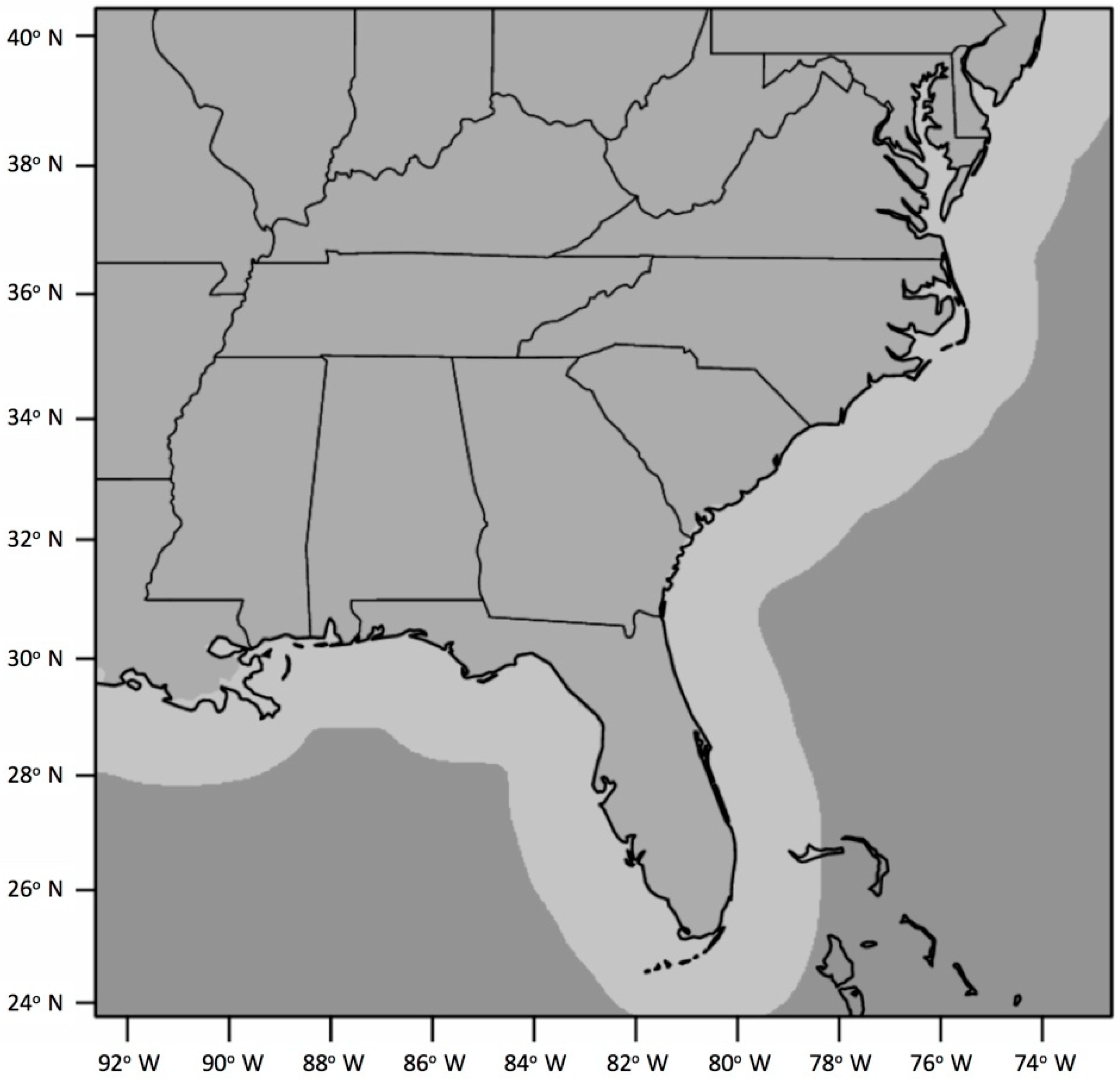
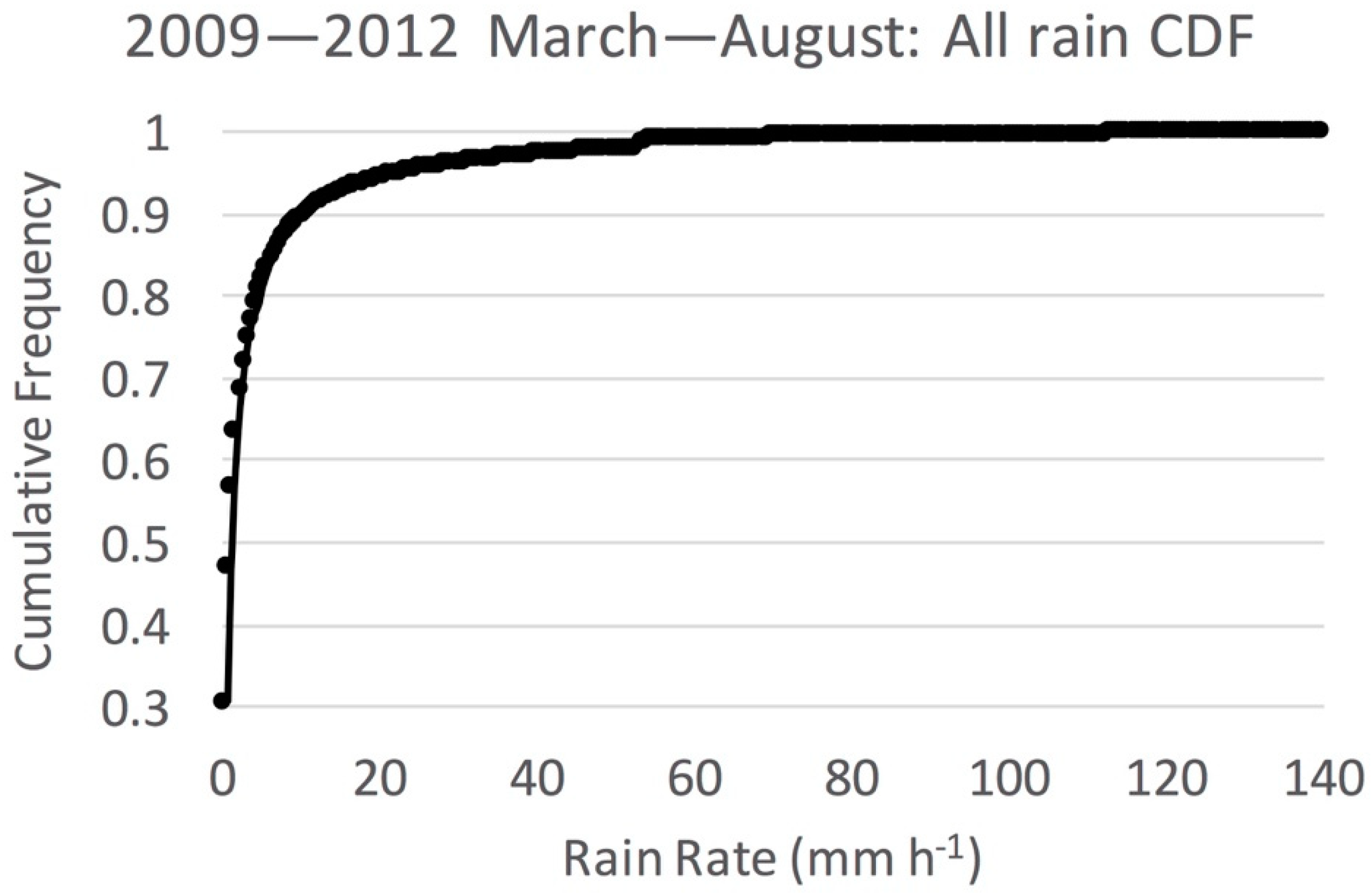
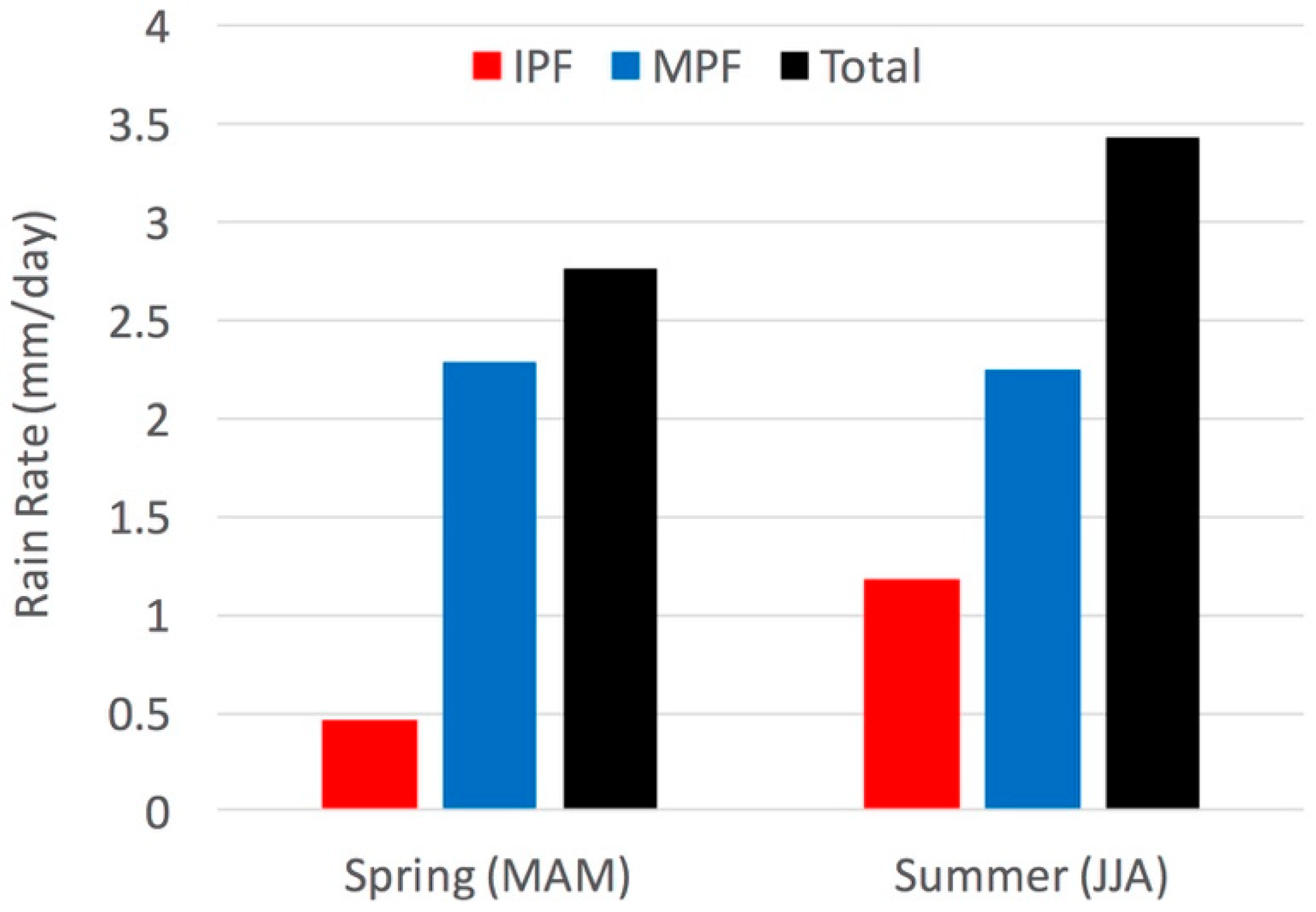
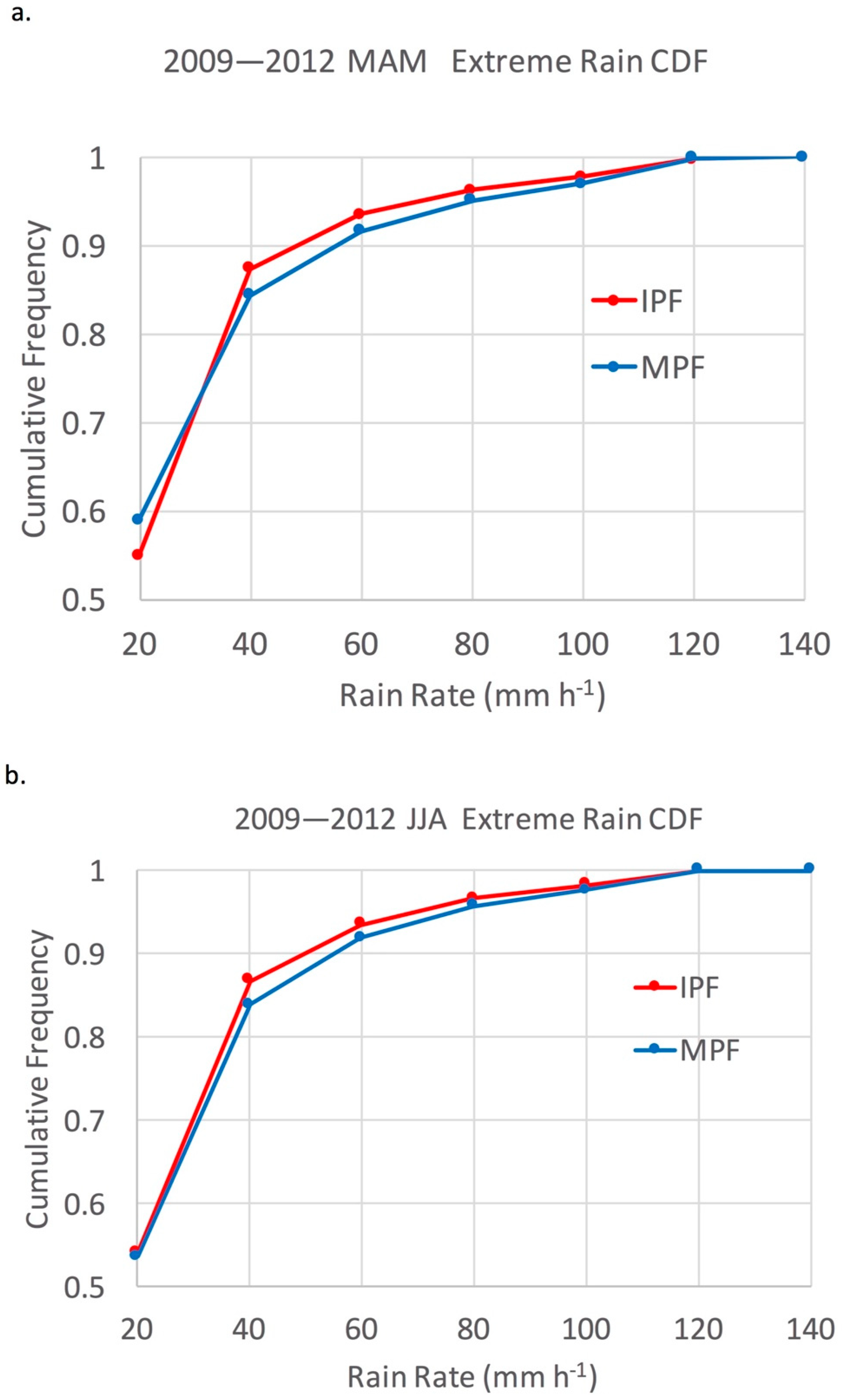
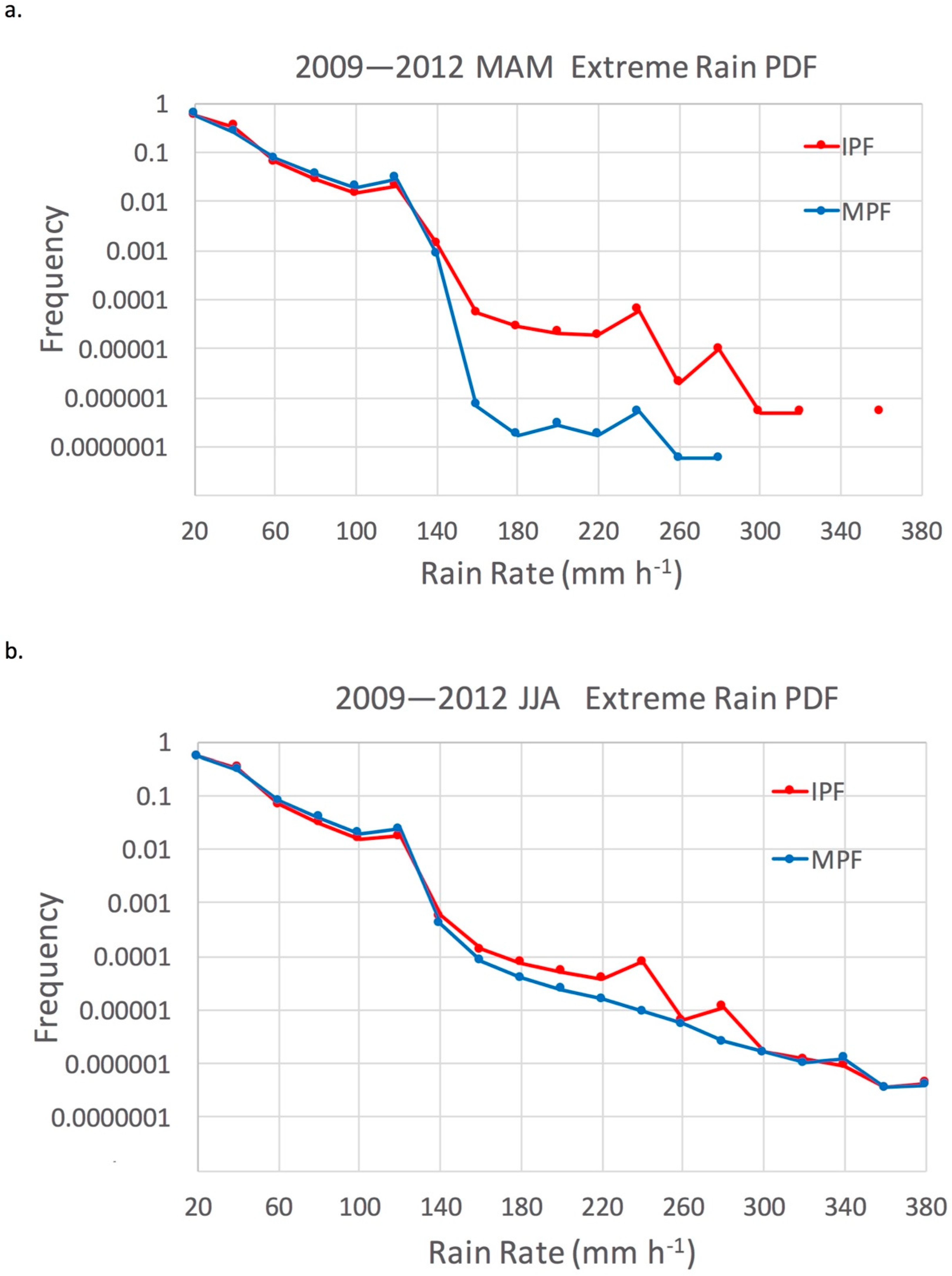
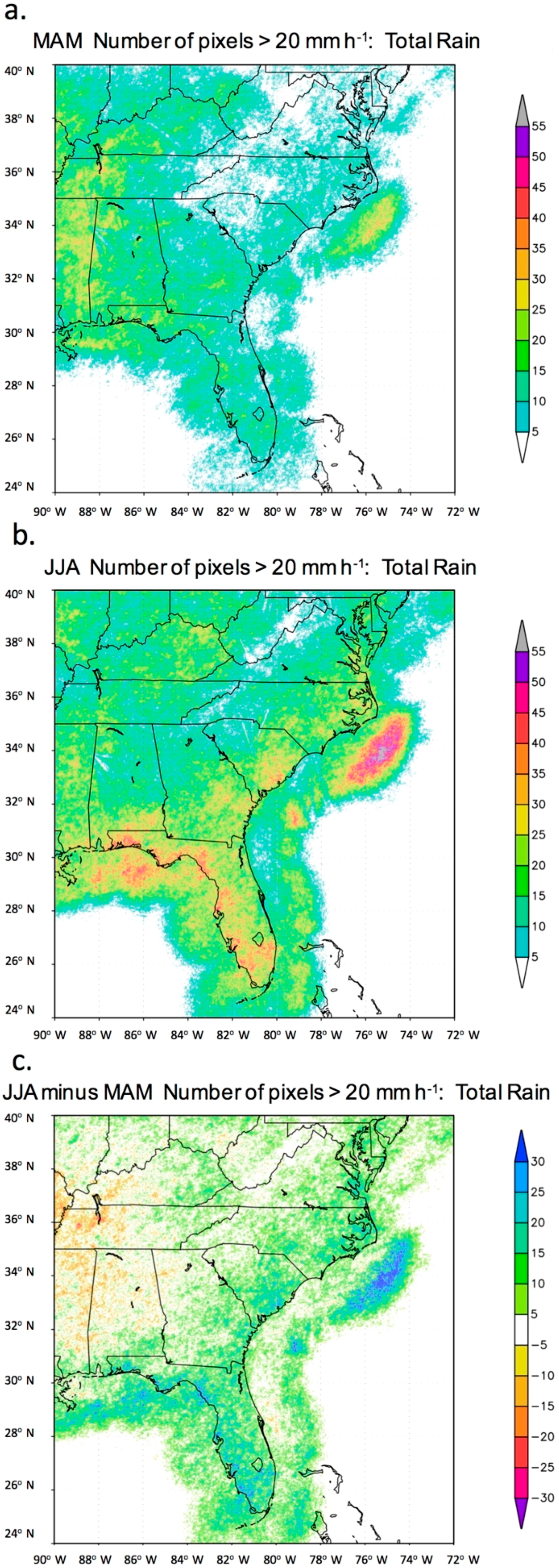
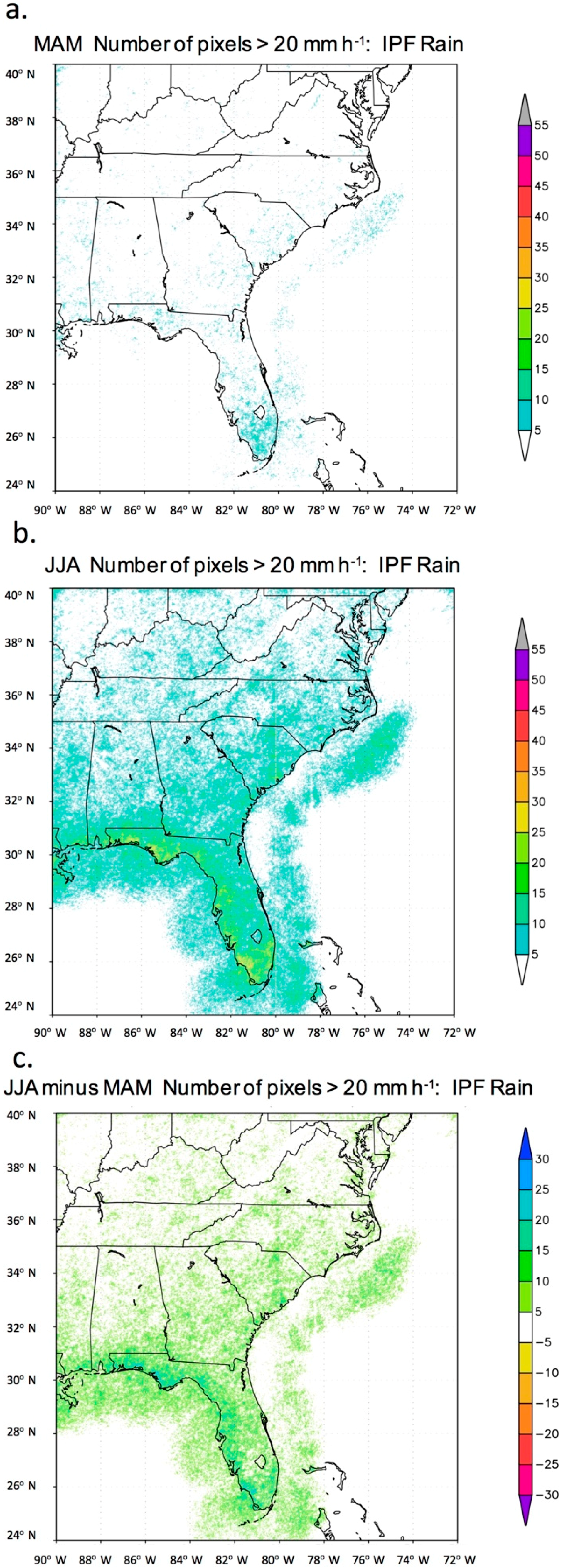

| SPRING (MAM) | SUMMER (JJA) | |
|---|---|---|
| IPF | 0.41 × 107 | 1.42 × 107 |
| MPF | 1.77 × 107 | 2.25 × 107 |
© 2018 by the author. Licensee MDPI, Basel, Switzerland. This article is an open access article distributed under the terms and conditions of the Creative Commons Attribution (CC BY) license (http://creativecommons.org/licenses/by/4.0/).
Share and Cite
Rickenbach, T. Seasonal Changes of Extremes in Isolated and Mesoscale Precipitation for the Southeastern United States. Atmosphere 2018, 9, 309. https://doi.org/10.3390/atmos9080309
Rickenbach T. Seasonal Changes of Extremes in Isolated and Mesoscale Precipitation for the Southeastern United States. Atmosphere. 2018; 9(8):309. https://doi.org/10.3390/atmos9080309
Chicago/Turabian StyleRickenbach, Thomas. 2018. "Seasonal Changes of Extremes in Isolated and Mesoscale Precipitation for the Southeastern United States" Atmosphere 9, no. 8: 309. https://doi.org/10.3390/atmos9080309
APA StyleRickenbach, T. (2018). Seasonal Changes of Extremes in Isolated and Mesoscale Precipitation for the Southeastern United States. Atmosphere, 9(8), 309. https://doi.org/10.3390/atmos9080309





